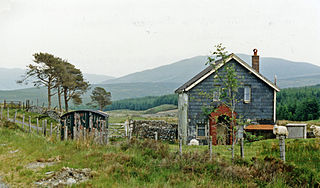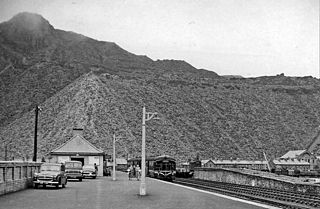
Blaenau Ffestiniog is a town in Gwynedd, Wales. Once a slate mining centre in the historic county of Merionethshire, it now relies heavily on tourists, drawn for instance to the Ffestiniog Railway and Llechwedd Slate Caverns. It was once the second largest town in North Wales, behind Wrexham. After reaching a population of 12,000 at the peak development of the slate industry, it fell with the decline in demand for slate. The population of the community of Ffestiniog, including the nearby village Llan Ffestiniog, was 4,875 in the 2011 census: the fourth most populous community in Gwynedd after Bangor, Caernarfon and Llandeiniolen. Blaenau's population is now only about 4,000.

Bala Junction railway station was on the Ruabon to Barmouth line in southern Gwynedd, Wales. It closed to passengers on Monday 18 January 1965. Bala Junction was unusual in that it was inaccessible by road and merely served as an interchange station; it was located about ¾ mile to the south-east of the town of Bala.
Capel Celyn Halt was a solely passenger railway station which served the rural area of Capel Celyn west of Bala. It was on the Great Western Railway's (GWR's) Bala Ffestiniog Line in Gwynedd, Wales.
Trawsfynydd Lake Halt was a solely passenger railway station near the northeastern tip of Llyn Trawsfynydd, Gwynedd, Wales. Many Nineteenth and early Twentieth Century institutions in Wales were given anglicised names, this station being one. Over the years, and especially since the Second World War, most have been rendered into Welsh or given both Welsh and English names. Trawsfynydd Lake Halt closed before this happened.

Trawsfynydd railway station served the village of Trawsfynydd, Gwynedd, Wales.

Manod railway station served the village of Manod which then stood on the southern edge of Blaenau Ffestiniog in Gwynedd, Wales. By 2015 urban spread had resulted in Manod being subsumed by its neighbour.

Tan-y-Manod railway station was a railway station approximately 1 mile (1.6 km) south of Blaenau Ffestiniog, in Gwynedd, North Wales.

Severalls Hospital was a psychiatric hospital in Colchester, Essex, England. It was managed by the North Essex Partnership University NHS Foundation Trust.
Tyddyn Bridge Halt was a solely passenger railway station which served a rural area west of Frongoch, near Bala. It was on the Great Western Railway's (GWR's) Bala Ffestiniog Line in Gwynedd, Wales.

Express Motors was a bus and coach hire company based in Penygroes, Gwynedd. The company operated public bus services in the Caernarfon, Porthmadog, Blaenau Ffestiniog, Bangor and Llandudno areas, as well as long-distance TrawsCambria service T2 between Bangor and Aberystwyth.
Bryn-Celynog Halt was an unstaffed solely passenger railway station which served the rural area of Bryn-Celynog, east of Trawsfynydd, Gwynedd, Wales.
Llafar Halt was an unstaffed solely passenger railway station which served the rural area of Glanllafar, east of Trawsfynydd, Gwynedd, Wales.

Cwm Prysor Halt was a railway station which served the remote rural area of Cwm Prysor, east of Trawsfynydd, Gwynedd, Wales.
Glynllifon Street railway station was a temporary northern terminus station of the Festiniog and Blaenau Railway (F&BR), sited between the street of the same name and Cwmbowydd Road in Blaenau Ffestiniog. It was never named.
Blaenau Ffestiniog (Pantyrafon) was the London and North Western Railway's (LNWR) first passenger station in Blaenau Ffestiniog, then in Merionethshire, now in Gwynedd, Wales. It opened on 22 July 1879 as a temporary structure for use until the company's permanent station opened on 1 April 1881, when the temporary structure closed. It was situated within yards of the southern portal of Ffestiniog Tunnel.
Blaenau Festiniog Junction railway station was the Festiniog Railway (FR)'s third of eventually five passenger stations in Blaenau Ffestiniog, then in Merionethshire, now in Gwynedd, Wales.

Blaenau Ffestiniog North was the London and North Western Railway's (LNWR's) second passenger station in Blaenau Ffestiniog, then in Merionethshire, now in Gwynedd, Wales.

On 10 September 1883 the Bala and Festiniog Railway (B&FR) and the Festiniog Railway (FR) opened what would nowadays be called an interchange station in Blaenau Ffestiniog, Merionethshire, Wales. Merionethshire is now part of the county of Gwynedd.

North west Wales experienced a slate boom in the first half of the nineteenth century. Three sites stood out as experiencing the most explosive growth: Dinorwic near Llanberis, Penrhyn near Bethesda and Blaenau Ffestiniog.
Diphwys railway station was on the same site as the later Great Western Railway station in the heart of Blaenau Ffestiniog in what was then Merionethshire, now Gwynedd, Wales.










